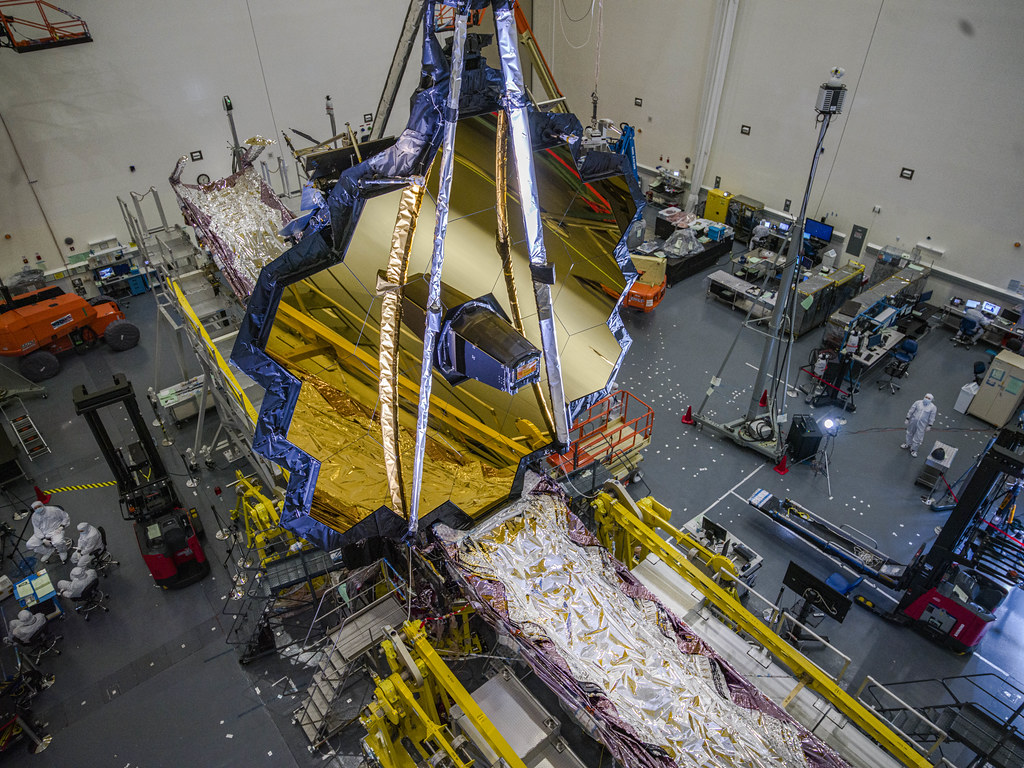
The James Webb Telescope (known as JWST or Webb) has successfully completed its acoustic and vibration tests. NASA reports that after a successful test for deployment in flight configuration, the observatory will be fully ready for flight into space.
Tests have confirmed that the observatory will withstand the deafening noise, destructive rumble and strong vibrations that accompany takeoff. The tests became the final tests of the JWST before being sent to launch in French Guiana.

telescope is planned to be sent into space from the Arianespace ELA-3 launch complex at the cosmodrome located near Kourou in French Guiana. The launch of the telescope into orbit is scheduled for October 31, 2021. "James Webb" in the future should become the main of the orbiting observatories.
The launch of the project is postponed for 13 years. Its total cost exceeds $ 10 billion. It will operate for 5-10 years in a halo orbit around the second Lagrange point (L2) in the Sun-Earth system.

JWST preparation and launch is a joint responsibility of NASA, ESA, NGAS and Arianespace.
Webb almighty
The creators promise that the JWST will be the most complex, powerful and largest telescope ever launched into space. This orbiting observatory will expand and complement the discoveries of the Hubble telescope with a wide range of research instruments and better sensitivity. Mid- and near-range infrared detectors will allow the telescope to look inside the dusty clouds where stars and planetary systems are forming.

The James Webb 's payload is approximately 6.2 tons, including the observatory, in-orbit consumables, and the launch vehicle adapter.
One of the telescope's global missions is to figure out what the universe was like after the Big Bang. "James Webb" will be able to observe distant galaxies, located at a distance of 13 billion light years from us. For these observations, the telescope needs an impressive mirror. The sensitivity and the amount of detail that a telescope can distinguish depends on the area of the mirror area. The mirror collects light: the larger it is, the more light it collects.
JWST engineers have determined that a 6.5 meter mirror is needed to achieve the stated goals. It turned out that making such a mirror is not easy. An object of this size has never been launched into space. For comparison, the diameter of the Hubble mirror is 2.4 meters. But if you scale it down to the desired diameter, it will be too heavy. Another task that the engineers were solving was to make a mirror not only large, but also ultra-light. Strong and light beryllium was chosen as the material.
The mirror was built foldable to fit into the launch vehicle. It consists of 18 hexagonal segments and will be expanded upon launch into space.
Hubble VS Webb
JWST will not replace the Hubble Telescope, but will be its successor. Telescopes have different capabilities.

JWST looks at the Universe in infrared light, while Hubble mainly studies it in the optical and ultraviolet wavelengths. The capabilities of James Webb are broader in this regard. Its coverage will be in the wavelength range from 0.6 to 28 microns. Hubble instruments allow you to observe a small part of the infrared spectrum from 0.8 to 2.5 microns. And its main capabilities in the ultraviolet and visible parts of the spectrum are from 0.1 to 0.8 microns.
Thanks to the large mirror, JWST will be able to look farther than Hubble. This is also facilitated by the fact that the Hubble is in orbit close to the Earth. While JWST will be at a distance of 1.5 million km from the second Lagrange point (L2).

The James Webb will have a much larger field of view than the NICMOS Hubble telescope camera, and about 15 times the area.
The Hubble is launched by the space shuttle, and the JWST will be launched on the Ariane 5 rocket with a cryogenic booster, because the telescope will not be in low-Earth orbit, but much further away.
